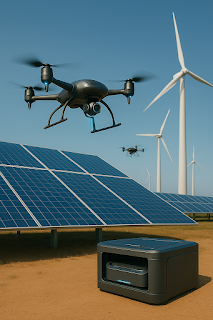The renewable energy sector is undergoing a digital revolution. One of the most promising developments is the rise of AI-powered drones. These intelligent flying machines are rapidly changing how solar farms, wind installations, and other clean energy infrastructure are managed—making them more efficient, safer, and cost-effective.
The Need for Innovation in Renewable Operations
Despite the global push for clean energy, operations and maintenance (O&M) remain costly and labor-intensive. Wind turbines and solar farms often cover vast, remote terrains where manual inspections are time-consuming and risky.
Challenges Include:
Weather-related wear and tear
Equipment degradation
Data fragmentation across sites
Safety concerns for human inspectors
What Are AI-Driven Drones?
AI-driven drones are unmanned aerial vehicles (UAVs) equipped with:
High-resolution and thermal imaging cameras
Real-time data analytics
Predictive maintenance capabilities
Machine learning algorithms for anomaly detection
These systems not only capture data but also analyze it instantly to generate actionable insights.
Applications in the Renewable Sector
a. Solar Farms
Thermal Scanning: Identifies underperforming photovoltaic (PV) panels.
Predictive Maintenance: Flags modules before failure occurs.
Automated Reporting: Converts raw data into diagnostic reports in minutes.
b. Wind Turbines
Blade Inspection: Detects cracks, erosion, and bird strikes.
Safety: Eliminates the need for rope-access inspectors.
c. Bioenergy and Hydro Sites
Surveillance & Mapping: Monitors structural integrity and vegetation growth.
Benefits of AI-Powered Drone Technology
Case Studies: Proven Impact
ENGIE’s Goorambat East Solar Farm (Australia)
Bouygues Construction and Equans Solar are trialing AI-powered autonomous piling and drone systems. This project, involving over 500,000 solar panels, has seen:
A 30% reduction in labor costs
Improved tracking of installation accuracy
Fewer delays due to real-time progress monitoring
U.S. Wind Farms
Companies like SkySpecs have deployed drones with AI algorithms that track turbine blade wear over time, extending turbine life by up to 25%.
Challenges and Limitations
Despite the promise, this technology isn’t without challenges:
High initial setup costs
Regulatory hurdles around autonomous flight
Data security and privacy concerns
Technical issues in harsh weather conditions
The Future: Fully Autonomous Drone-in-a-Box Systems
Drone-in-a-Box (DIAB) solutions, where drones are stored, charged, and deployed autonomously from a ground station, are the next step. These allow for:
Scheduled routine inspections
Immediate responses to alerts
Remote monitoring from anywhere in the world
Conclusion: A Smart Sky for Clean Energy
AI-powered drones are no longer just experimental gadgets—they are vital tools in the renewable energy toolkit. By merging aerial intelligence with advanced analytics, they empower developers, operators, and investors to make better, faster, and greener decisions. As the renewable sector continues to expand, these sky-borne sentinels will help ensure a sustainable and resilient energy future.


No comments:
Post a Comment